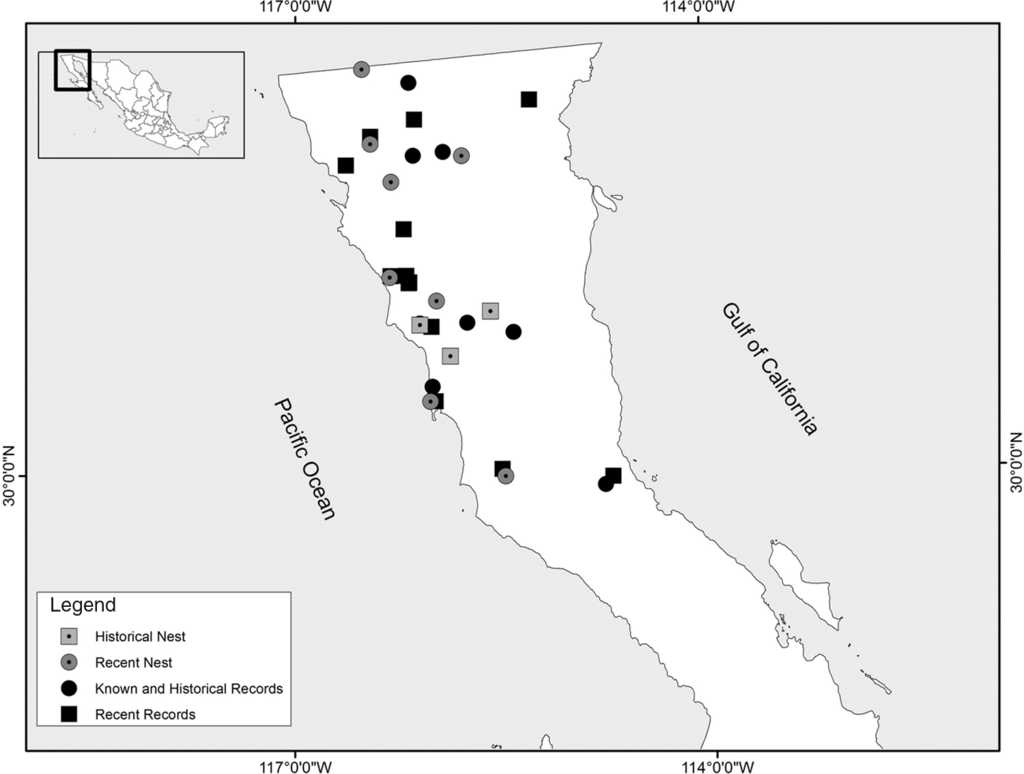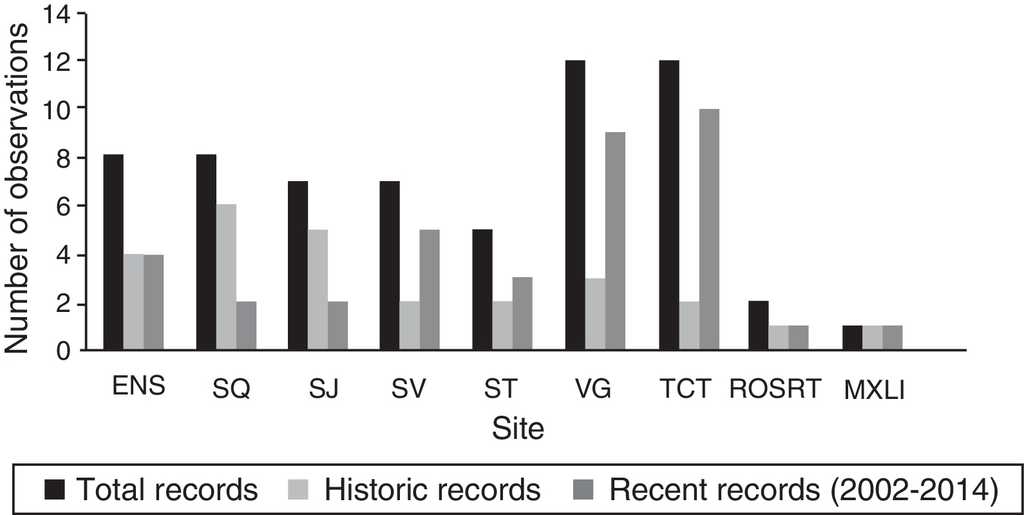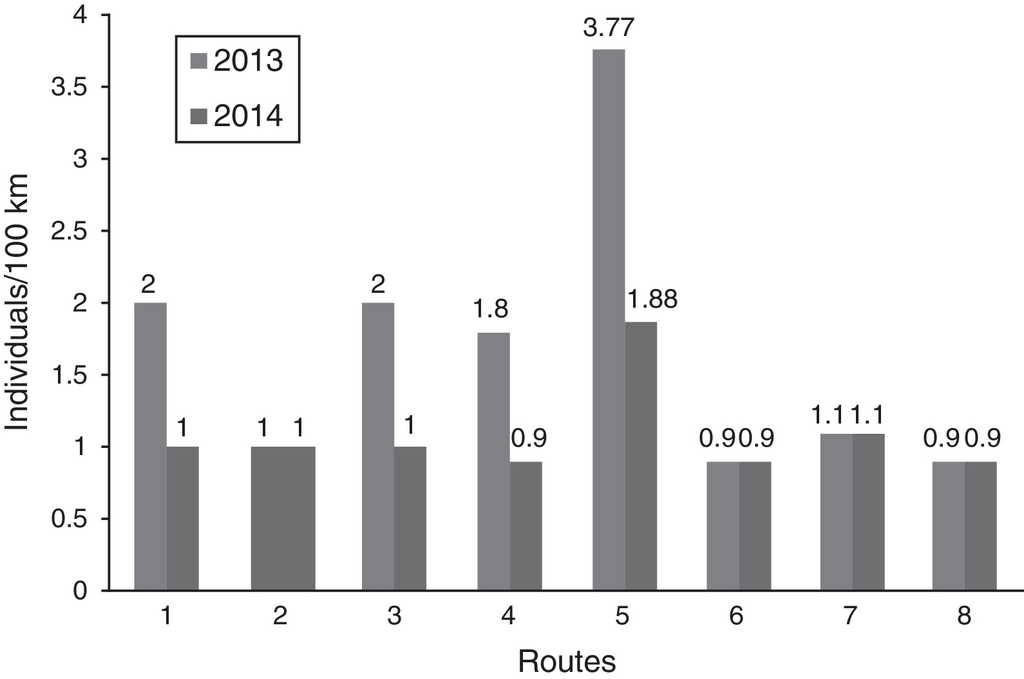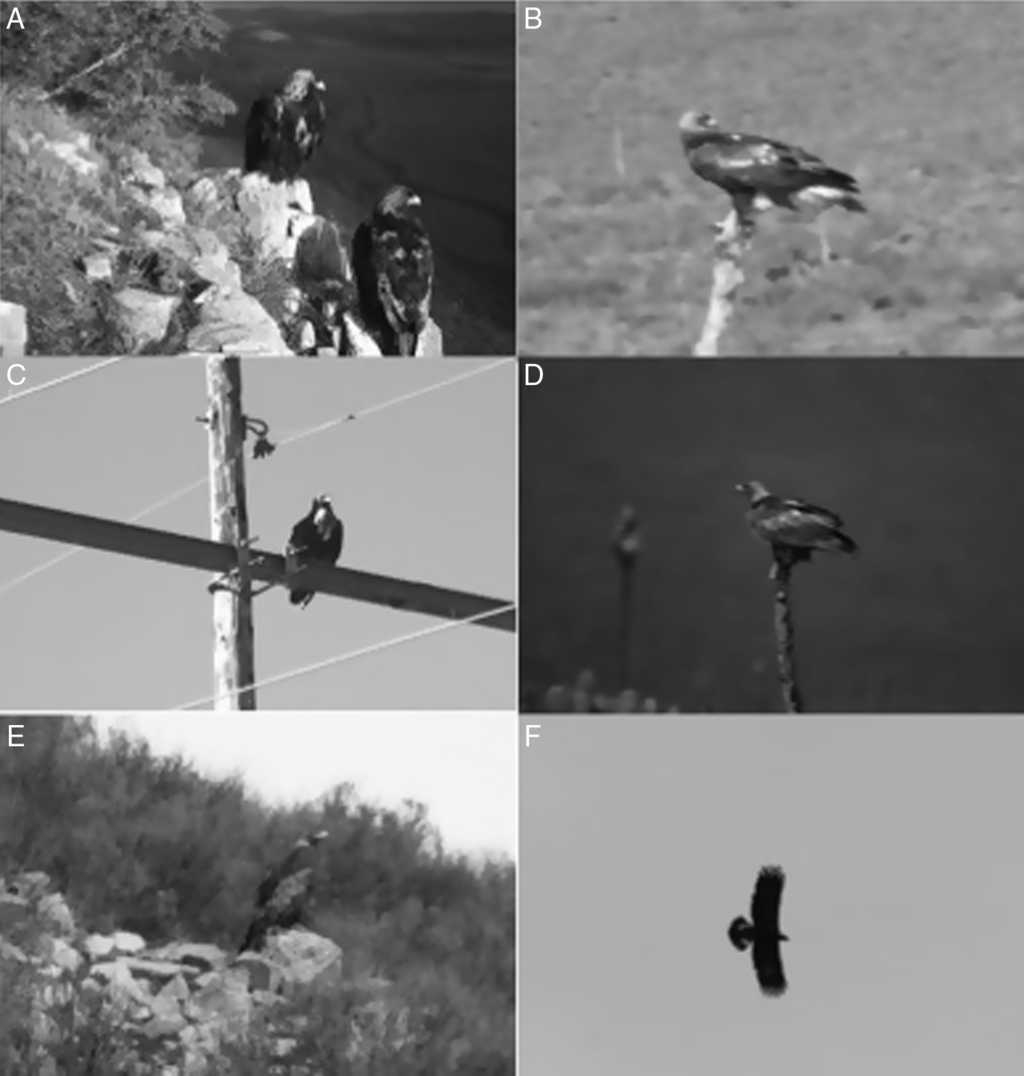Introduction
The Golden Eagle (Aquila chrysaetos) is a top predator widely distributed throughout the world in terrestrial ecosystems, with populations in America from Alaska, Canada, the United States, Northern México, including the Baja California peninsula, to central México (Kochert & Steenhof, 2002; Kochert, Steenhof, McIntyre, & Craig, 2002; Newton, 1979; Rodríguez-Estrella, 2002; Watson, 2010). This species receives special concern in North America (Good, Nielson, Sawyer, & McDonald, 2007; Katzner et al., 2012; Kochert & Steenhof, 2002) and Europe (Watson, 1992; Whitfield, Fielding, McLeod, & Haworth, 2008).
In the United States, the Golden Eagle is listed as a species of concern by numerous states and federal agencies, including the California Department of Fish and Game, who considers it as “fully protected” since 1918. In spite of protection, Golden Eagle populations have shown a decrease in southern California (Harlow & Bloom, 1989) and in the U.S. eastern region (Boal, Haralson, & Howe, 2008; Hoffman & Smith, 2003; Katzner et al., 2012; Kochert & Steenhof, 2002; Millsap et al., 2013). Although some populations occurring in locations with no anthropogenic influence suggest a stable trend (Millsap et al., 2013).
In México, the Golden Eagle is considered as a threatened species (NOM-059- Semarnat-2010; Semarnat, 2010) due to population decline resulting from habitat loss, pesticide poisoning, poaching and electrocution, among other hazards (Rodríguez-Estrella, Llinas, & Cancino, 1991; Semarnat, 2008). Due to its legal status and importance in ecosystems, several specific conservation programs have been implemented in México (Semarnat, 2008). However, little is known about historical and current records of the Golden Eagle in México, particularly in the Baja California peninsula (Rodríguez-Estrella, 2002).
Historical records of the presence of Golden Eagles in Baja California date back to the late 19th century (Anthony, 1893), with subsequent occasional and sporadic records, particularly for the central region of the peninsula (Rodríguez-Estrella, 2002). In this paper, we document the distribution, abundance and nesting records (both historical and recent) of Golden Eagles in northwestern Baja California, in order to assist in evaluating its current conservation in the most southwestern region of North America. Information obtained here might be useful for the development of research lines focused on restoration and conservation, and could also be used in the formulation of public policies aimed at the conservation of this species at federal and regional levels.
Materials and methods
The Baja California peninsula is 1,250 km long and 100 km of average width, with a mosaic of climatic conditions along a latitudinal and altitudinal gradient with temperatures ranging from 1 °C to 25 °C (Mediterranean climate) in the highlands, and from 25 °C to 30 °C in lowland deserts (Inegi, 2001; Rzedowski, 1978). The study area encompasses the northern part of the peninsula (Fig. 1), with dominant vegetation composed of chaparral and coastal sage scrub in lowlands, and coniferous forest in high mountains (Delgadillo, 1998). Coastal sage scrub vegetation ranges from sea level to 600 m, dominated by Artemisia californica and Rhus integrifolia. The chaparral vegetation occurs from 600 to 1,800 m and is composed mainly by perennial plants of the genera Ceanothus, Arctostaphylos and Adenostoma. Coniferous forest is represented in the Sierra de Juárez and Sierra de San Pedro Mártir along elevations ranging from 1,200 to 3,000 m; being the dominant species in both mountains Pinus jeffreyii and Pinus quadrifolia. In Lower Colorado River and Central Deserts districts of Baja California, the vegetation is dominated by desert elements such as Larrea tridentata and Fouquiera splendens (Peinado, Alcaraz, Delgadillo, & Aguado, 1994).

Figure 1 Locations of historical (1970 and 1992) and recent (2002-2014) records of Golden Eagle in Baja California, Mexico, including the historical (1893-2002) and recent (2011-2014) nesting records.
Occurrence records of the Golden Eagle in Baja California were compiled from 6 sources: (1) historical sighting records published prior to 1995; (2) voucher specimens or egg records in museums, both, in Mexico and in the USA; (3) unpublished sighting records generated by the authors between 1995 and 2007; (4) occasional photographic records obtained by the authors during 2002-2014; (5) recent sighting records through systematic monitoring (January 2013 to November 2014), and (6) records filed in the North American Birds database (R.A. Erickson, pers. comm.).
We used the definition of active nest as defined by Postupalsky (1974) by referring to the place where: (1) the young were raised, (2) eggs were laid, (3) 1 adult was observed and in incubation position, (4) 2 adults were observed on or near the nest, (5) 1 adult and 1 eagle in subadult plumage were observed in or near the nest and mating behavior also was observed, and (6) the nest was repaired and fresh sticks and Golden Eagle feathers molted that year were present.
Information of egg records and voucher specimens of the Golden Eagle from Baja California was consulted or requested in the following bird collections: Colección Ornitológica de la Universidad Autónoma de Baja California, Ensenada, Baja California, México (CO-UABC); Museo de Zoología “Alfonso L. Herrera” from the Departamento de Biología Evolutiva from Universidad Nacional Autónoma de México (MZFC-UNAM); The Western Foundation of Vertebrate of Zoology, Camarillo, California (WFVZ); The Museum of Vertebrate Zoology, Berkeley, California (MVZ); The San Diego Natural History Museum, San Diego, California (SDNHM); The Natural History Museum of Los Angeles County (LACM); and The Field Museum of Natural History (Birds), Chicago, Ill. (FMNH).
Recent sighting records of the Golden Eagle in the study area were obtained through the scanning of 8 transects (100 km-long) during breeding seasons (January-March 2013 and 2014) and non-breeding seasons (August-December 2013 and 2014). Each transect covered the same routes and was performed from a car on roads and trails in the study area, driving at an average velocity of 40 km/h. We traveled approximately a total of 1,634 km during 2 years, covering most of the state below 360 km of the south international border (Table 1). For each individual observed, habitat type, activity, age (subadult/adult) and sex (when possible) was recorded. In the case of detected nests, we analyzed them based on the characteristics proposed by Postupalsky (1974): (1) activity in the nest, (2) presence of eggs o chicks, (3) number of alternate nests, (4) type of structure where the nest is built, and (5) anthropogenic activity near the nesting site. All records were spatially located using a GIS. Sites records were classified in 11 areas including: Valle de los Cirios, Sierra de San Pedro and vicinity, Sierra de Juárez, Valle de San Vicente, Valle de Santo Tomás, Ensenada town and vicinity, Bahía San Quintín, Valle de Guadalupe, Valle de Ojos Negros, and vicinities of Rosarito and Tecate.
Table 1 Number of Golden Eagles recorded during terrestrial transects during breeding seasons (January-March 2013-2014) and non-breeding seasons (August-December 2013-2014), in northwestern Baja California, México.
| Number of route | Name of the route | Length (km) | 2013 | 2014 | Total number of individuals detected per 100 km (2 years combined) | Mean number of individuals per 100 km |
|---|---|---|---|---|---|---|
| 1 | El Rosario to Colonia Vicente Guerrero | 100 | 2 | 1 | 3 | 1.5 |
| 2 | Colonia Vicente Guerrero to National Park Sierra de San Pedro Mártir | 100 | 1 | 2 | 3 | 1.5 |
| 3 | San Telmo to Valle de La Trinidad | 98 | 2 | 1 | 3 | 1.5 |
| 4 | Valle de La Trinidad to Ensenada City | 111 | 2 | 1 | 3 | 1.5 |
| 5 | Ensenada City to Tecate City | 106 | 4 | 2 | 6 | 3.0 |
| 6 | Tecate City to National Park Constitución de 1857 | 103 | 1 | 1 | 2 | 1.0 |
| 7 | San Telmo to Ensenada City | 88 | 1 | 1 | 2 | 1.0 |
| 8 | El Mármol to El Rosario | 111 | 1 | 1 | 2 | 1.0 |
| Total (for 2 years combined) | 1,634 | 14 | 10 | 24 | ||
| Average | 102.1 | 1.7 | 1.2 | 3 | 1.5 ± 0.6 |
In order to quantify the density of potential prey in the areas adjacent to nesting sites, we sampled plots of 300 m in length and 200 m wide (Ruiz-Campos et al., 2014). In each nesting site, the composition and density of prey were determined twice a day, from 6:00 to 10:00 h and 18:00 to 20:00 h. The density of prey for each nesting site was determined as number of prey per hectare. All plots were sampled during the nesting and non-nesting seasons. The number of plots for the eleven nesting sites in 2013 were as follows: December (2), February (2), May (2), August (2), and November (2); likewise, the same number of plots were sampled for 2014.
Several habitat variables associated to the sites of detection or nesting were determined, considering altitude, nest structure, type of vegetation, abundance of potential prey, and lineal distance from urban activities. We classified 3 intervals of altitude (0-400 m, 401-800 m, and 801-1,200 m). All nests detected in the study area were found on cliffs. Types of vegetation present in the site study were classified as follows: (1) natural vegetation, (2) natural vegetation-secondary vegetation, (3) secondary vegetation, and (4) urban zone. In each site we sampled the abundance of potential prey by means of the strip census method (Ruiz-Campos et al., 2014), where 4 plots (300 m long × 200 m effective width) were made; abundance ranges were defined as: 0-1 prey/ha, 2 prey/ha, and ≥3 prey/ha. Lineal distances from the nesting sites to urban zones were obtained from Google Earth maps, which were classified in 4 categories: 1-5 km, 6-10 km, 11-20 km, and 21-40 km.
Independence X 2 tests (α = 0.05, Zar, 1999) were used to determine the relationship between the reproductive success categories (0 chicks, 1 chick and 2 chicks) and each one of the habitat components (altitude, nest structure, type of vegetation, abundance of potential prey, and lineal distance to urban activities). We used a Mann-Whitney rank sum test (Siegel & Castellan, 1988) to compare the abundance of individuals observed per transect between years (2013 and 2014). All the statistical analyses were at a level of significance of 0.05.
Results
We compiled information for 101 individuals of the Golden Eagle recorded for Baja California between 1843 and 2014 (37 historical records plus 64 new records). The individuals detected correspond to 17 adults, 24 subadults and 60 unknown age (Fig. 2).

Figure 2 Comparison of the total number of sightings (historical and recent) for Golden Eagle in Baja California, Mexico. ENS (Ensenada and vicinity), SQ (San Quintín), SJ (Sierra de Juárez), SV (Valle de San Vicente), ST (Valle de Santo Tomás), VG (Valle de Guadalupe), TCT (Tecate), ROSRT (Rosarito) and MXLI (Mexicali).
In this analysis, we also documented 11 nesting records (3 historical and 9 recent) for the Golden Eagle in Baja California (Table 2). Two of the historical nesting sites (Santo Domingo [Erickson, Patten, Palacios, & Carmona, 2002] and Sierra de San Pedro Mártir, J. Vargas, pers. comm.) remain active with young. Altitude range of current nesting records varied from 350 to 2,200 m, where the nesting distance from human settlements ranged between 1 and 11 km (Table 2).
Table 2 Location of historical (H) and recent (R) nesting records of Golden Eagle in northwestern Baja California, México, monitored from February 2013 to April 2014, indicating the content of detected nest (a=chicken, b=fledged, and 0=inactive nest or not used), structure where the nest was built, vegetation type of the nesting site, and human activity into a 10km radius around the nest.
| Type of record | Location | Established nests | Total | Altitude (m) | Nest structure | Vegetation type | Human activity | Reference | |
|---|---|---|---|---|---|---|---|---|---|
| 2013 | 2014 | ||||||||
| H | San Telmo | 0 | 0 | 0 | 200 | Cliff | Chaparral | Suburban and agriculture | Anthony (1893) |
| H | Santo Domingo | 1b | 2b | 3 | 427 | Cliff | Chaparral and riparian vegetation | Suburban and agriculture | Erickson et al. (2002) |
| H | Sierra de San Pedro Mártir | 1b | 1b | 2 | 2,226 | Cliff | Mix forest, with coniferous forest and chaparral | Absent | This study |
| Ra | Valle de Ojos Negros | 0 | 0 | 0 | 330 | Cliff | Secondary vegetation | Agriculture | This study |
| R | Santo Tomás | 0 | 1b | 1 | 527 | Cliff | Coastal sage scrub | Agriculture | This study |
| R | Sierra Juárez | 0 | 1b | 1 | 958 | Cliff | Coniferous forest and chaparral | Absent | This study |
| R | Valle de Guadalupe | 1b | 2a | 3 | 662 | Cliff | Coastal sage scrub and secondary vegetation, | Agriculture | Gallo-Corona and Rodríguez-Estrella (2010) |
| R | El Rosario | 1b | 0 | 1 | 500 | Cliff | Desert vegetation | Absent | Rodríguez-Estrella (2014) |
| Ra | San Quintín | 0 | 0 | 0 | 167 | Cliff | Coastal sage scrub | Agriculture, urban | This study |
| R | Tecate | 1a | 1b | 2 | 956 | Cliff | Chaparral, secondary vegetation | Agriculture, urban | This study |
| R | San Vicente | 1a | 1b | 2 | 348 | Cliff/man-made structure | Coastal sage scrub | Agriculture | This study |
| Total | 5 | 8 | 13 | ||||||
a Nest inactive or not used.
The 9 active nests of the Golden Eagle detected in this study differed in the geographic orientation. Four nests had a northeast exposure (Sierra de Júarez, Valle de Guadalupe, San Vicente and Valle de Ojos Negros), 2 with a northwest (Sierra San Pedro Mártir and Tecate), 2 with a southeast (Santo Domingo and El Rosario), and finally 1 with a southwest exposure (Santo Tomás). All these nests were built on cliffs (6 of them on platforms with roofs) throughout an elevation range from 167 to 2,226 m asl, except one that was located on an artificial platform (Table 2).
We found 7 voucher specimens of the Golden Eagle from Baja California from the following museums: 1 specimen, Museum of Vertebrate Zoology at Berkeley (MVZ-50475) from Laguna Hanson, Sierra de Juárez, 21 October 1926 (http://mvz.berkeley.edu/bird-collection.html); (2) 1 specimen, The Field Museum of Natural History at Chicago (FMNH-338722) from Isla San Lorenzo, Baja California [Norte], 1 March 1973 Collection, Universidad Autónoma de Baja California, at Ensenada, Baja California: UABC-092, Rosarito town, 01 March 1996; UABC-820, Rosarito town, 12 October 1995; UABC-1783, Bahía San Quintín, 29 April 2007; UABC-1989, Valle de Ojos Negros, 18 September 2013; and uncataloged specimen collected in Valle de Ojos Negros, 20 January 2014. The UABC Bird Collection contains the highest number of voucher specimens for the Golden Eagle from the Baja California peninsula.
The highest number of historical (HR) and recent (RR) records of the Golden Eagle in Baja California was found in coastal valleys of the northwest region (70); while a smaller number of sightings occurred in highland biotopes (20) and deserts (11). Based upon vegetation types in the study area, most of sightings for this species were made in coastal sage scrub (54), while 9 in coniferous forest, 27 in chaparral, and 11 in desert scrub. Most records were made between 2002 and 2014, especially in the Valle de Guadalupe (HR: 3 vs RR: 8) and in the vicinity of Tecate (HR: 2 vs RR: 12; Fig. 2). In the study area, Lepus californicus, Sylvilagus audubonii and Otospermophilus beecheyi were commonly detected during sampling of potential prey in the sites adjacent to nesting sites of the Golden Eagle.
We surveyed 634 km of routes for detection of the Golden Eagle during 2 consecutive years combined (2013-2014), where 24 individuals were registered (1.5 ± 0.6 individuals/100 km). The Ensenada-Tecate route recorded the mean highest abundance with 3 individuals/100 km. The total number of chicks or fledged recorded in the study area was 5 and 8 for 2013 and 2014, respectively, with an average of 1.4 chicks per nest for both combined years (Fig. 3). The number of Golden Eagles detected/100 km in the 8 routes of sampling was statistically similar between 2013 and 2014 (Mann-Whitney Rank Sum Test, T = 59.0, p > 0.06).

Figure 3 Number of Golden Eagles registered in 100km for terrestrial transects during breeding season (January-March 2013-2014) and non-breeding season (December 2013-2014) in Baja California, Mexico.
Density of potential prey items per plot (300 m long × 200 m width) in 10 sampling sites varied from 0.23 (El Rosario) to 2.33 (San Vicente), with an average density of 1.34 ± 0.73 prey. The relationship of number of chicks per nest and habitat variables resulted to be statistically independent (p > 0.05) for density of potential prey (X 2 = 1.89, 4 d.f.), types of vegetation (X 2 = 4.79, 6 d.f.), altitude categories (X 2 = 4.16, 4 d.f.), and lineal distance to urban areas (X 2 = 6.75, 6 d.f.) (Fig. 4).

Figure 4 Photographs of Golden Eagle in northwestern Baja California. (A) Pair, Valle de Guadalupe, 01 Febrero 2015, Gonzalo De León-Girón; (B) adult (unknown sex), Valle de San Vicente, 4 April 2002, Gorgonio Ruiz-Campos; (C) sub-adult, Valle de San Vicente, 8 August 2014, Gonzalo De León-Girón; (D) adult (unknown sex), near Colonet town, 25 March 2011, Gorgonio Ruiz-Campos; (E) adult (female), Valle de Guadalupe, 20 May 2015, Gonzalo De León-Girón; and (F) sub-adult (first year), Valle de Guadalupe, 21 February 2014, Gonzalo De León Girón and Ricardo Rodríguez-Estrella.
Discussion
The Golden Eagle is one of the most emblematic vertebrate species found in Mexico with reports of occurrence in the Baja California peninsula for over 100 years. One hundred and one individuals were recorded from 1843 to 2014 (Erickson et al., 2002; Gallo-Corona & Rodríguez-Estrella, 2010; Grinnell, 1928; Rodríguez-Estrella et al., 1991; Rodríguez-Estrella, 2002; Ruiz-Campos, Palacios-Castro, Castillo-Guerrero, González-Guzmán, & Batche-González, 2005; Wilbur, 1987; this study). Most of the records of the Golden Eagle in the State of Baja California, both historical and recent, were recorded in the northwest region during autumn and winter conditions, and were mainly sub-adult individuals (North American Birds database; this study).
Biogeographically, the Golden Eagle has not exhibited historical changes in distribution in the Baja California peninsula. Our recent records of this species (2000-2014) allow to confirm its presence for most historical sites such as San Pedro Mártir and vicinities, Sierra de Juárez, and Valle de los Cirios (Rodríguez-Estrella, 2002). These sites are still characterized by having little or no anthropogenic disturbances and favorable ecological conditions for nesting of this species. Two of the known nesting sites (Sierra de San Pedro Mártir and Santo Domingo) have been active during at least the last 20 years.
Mean number of Golden Eagle chicks per nest recorded in this study was 1.4 for 2013 and 2014, combined. This last value was comparatively higher than those reported for a period of 10 years in Oregon (1.08, Thompson, Johnstone, & Littlefield, 1982), Utah (0.82, Bates & Moretti, 1994), Montana and Wyoming (0.78, Phillips, Wheeler, Lockhart, McEneaney, & Forrester, 1990), southwest Idaho (0.79, Steenhof, Kochert, & McDonald, 1997), and Alaska (0.66, McIntyre & Adams, 1999).
We found that the number of Golden Eagle chicks in the study site during a period of 2 years (2013-2014) was independent of some habitat variables such as density of potential prey, altitude categories, types of vegetation, and distance to urban sites. In this sense, Kochert and Steenhof (2002) mentioned that Golden Eagle populations in the United States fluctuate on a 10 year cycle, concurrent with jackrabbit populations, so studies over periods of less than 10 years may not accurately reflect trends.
The orientation of nest exposure of Golden Eagles in our study area was similar to those reported for Alaska (Hayes, Mossop, & Barichello, 1980; Mosher & White, 1976; Ritchie & Curatolo, 1982) and other regions such as the Northwest Territories and Quebec (Morneau, Brodeur, Décaire, Carriére, & Bird, 1994; Poole & Bromley, 1988). Also, it is important to note that nests on platforms with roofs provide protection of the eggs or chicks against solar radiation, heat and strong winds (Morneau et al., 1994; Mosher & White, 1976; Poole & Bromley, 1988; Watson & Dennis, 1992); additionally, this type of nest also decreases the time spent by parents caring for the chicks (Collopy, 1984; McGahan, 1968).
Ecologically, 2 populations of Golden Eagles reside in Baja California, one permanent with resident breeding pairs, and the other, presumed migratory, with sub-adults and adults coming from the north, most likely from San Diego and Oregon (Rodríguez-Estrella, 2002; Rodríguez-Estrella et al., 1991; Watson, 2010). The presence of presumed migratory individuals and nonbreeding adults (“floaters”) of Golden Eagles in Baja California may be part of a process of succession of the resident breeding pairs in this region (Hunt, 1998). This pattern described here is congruent with the known status of Golden Eagle populations in México, which contains resident and non-breeding migrant populations (Rodríguez-Estrella, 2002).
Although the northern Baja California region is considered the southern limit of the distribution range of Golden Eagles in the western Pacific region (Rodríguez-Estrella, 2002; Watson, 2010), where peripheral populations are characterized by having low numbers of individuals. Several authors (e.g., Brown, Mehlman, & Stevens, 1995; Parmesan et al., 2005; Sergio et al., 2008; Schweiger, Fünfstück, & Beierkuhnlein, 2015) have assumed that the central population of this species is more stable and abundant than peripheral populations, and functioning as source populations for a sinking process at distribution edges. However, our recent records of Golden Eagles in the southwestern part of its distributional range in North America (Watson, 2010) could indicate the presence of an active breeding population. It is important to consider in future studies to carry out synchronous comparisons of the abundance, nesting success and homing ranges of Golden Eagles between northern Baja California and southern California in order to determine the population structure and dynamics in both regions.
The effective conservation of Golden Eagles in northern Baja California will always depend on a blend of different approaches, including species protection, site protection and conservation/management in protected areas and the broader environment (Watson & Whitfield, 2002). Therefore, we recommend strictly that the following areas of northern Baja California such as in vicinities of Tecate, Valle de Guadalupe, Valle de Santo Tomás and the 2 mountain systems (Juárez and San Pedro Mártir) be considered as priority regions for the permanent monitoring of nesting and sighting of Golden Eagles in Baja California, along with assessments of reproductive success, use and availability of potential prey in the environment.











 nueva página del texto (beta)
nueva página del texto (beta)


